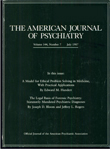Psychomotor Symptoms in Depression
TO THE EDITOR: Christina Sobin, Ph.D., and Harold A. Sackeim, Ph.D., in their well-structured review (1), examined the current knowledge regarding psychomotor symptoms of depression. Even though most areas of this field were covered in the article, we believe that two additional aspects of psychomotor symptoms in depression need to be considered.
The terms “agitation” and “retardation” with respect to depressive patients are not at all unequivocal and need to be defined more clearly. Agitation and retardation do not merely manifest themselves in observable behavior (signs) but represent also aspects of subjective experience (symptoms) in depression. When one uses these terms, it needs to be stated whether one is referring to observed psychopathological signs or symptoms experienced by the patient. Observable behavior may not reflect subjective experience in patients with psychiatric disorders. We examined daily changes of gross motor activity by actigraphy in depressed patients with melancholic features who experienced diurnal variations of mood and drive with improvement of symptoms during the course of the day (2). Patients showed greater motor activity in the morning compared to the evening. The central finding of our study was the inverse relationship between the amount of motor activity measured by actigraphy and subjectively experienced symptoms, including mood, drive, and activation measured by various self-rating scales.
The development of sophisticated technology to better analyze various components of psychomotor features appears to be necessary for research purposes. However, the development of clinical instruments for evaluation of motor symptoms in psychiatric patients is necessary to differentiate more clearly between observed psychopathological signs and experienced symptoms in clinical psychiatry. The retardation scale by Widlöcher (3) mentioned in the article has been used in different languages. However, this scale measures both observable signs and subjective symptoms. Parker et al. (4) developed a sign-based measure (CORE), which purely assesses multiple motor domains in depression and which we believe needs to be mentioned in the context of psychomotor measures. This instrument has been recently translated by our group, and its application to clinical and research matters needs further evaluation. Studies integrating different levels of pathological alterations associated with psychomotor phenomena may yield further evidence of underlying neurobiological and psychobiological mechanisms in depression and other psychiatric disorders.
1 Sobin C, Sackeim HA: Psychomotor symptoms of depression. Am J Psychiatry 1997; 154:4–17Link, Google Scholar
2 Lemke MR, Broderick A, Zeitelberger M, Hartmann W: Motor activity and daily variation of symptom intensity in depressed patients. Neuropsychobiology 1997; 36:57–61Crossref, Medline, Google Scholar
3 Widlöcher DJ: Psychomotor retardation: clinical, theoretical, and psychometric aspects. Psychiatr Clin North Am 1983; 6:27–43Crossref, Medline, Google Scholar
4 Parker G, Hadzi-Pavlovic D, Wilhelm K, Hickie I, Brodaty H, Boyce P, Mitchell P, Eyers K: Defining melancholia: properties of a refined sign-based measure. Br J Psychiatry 1994; 164:316–326Crossref, Medline, Google Scholar



